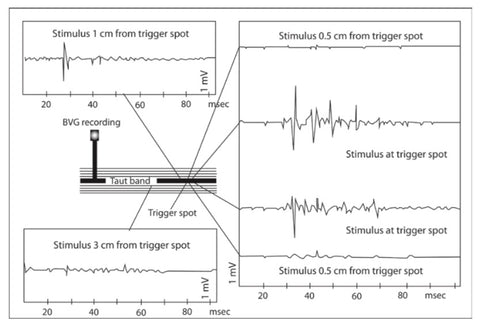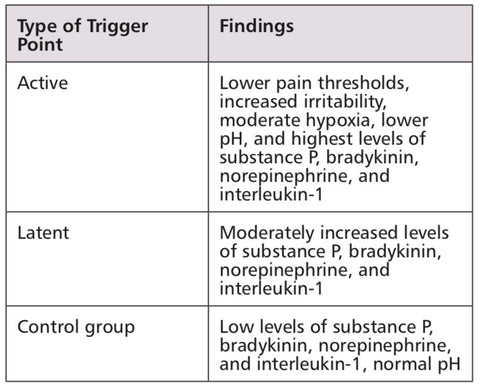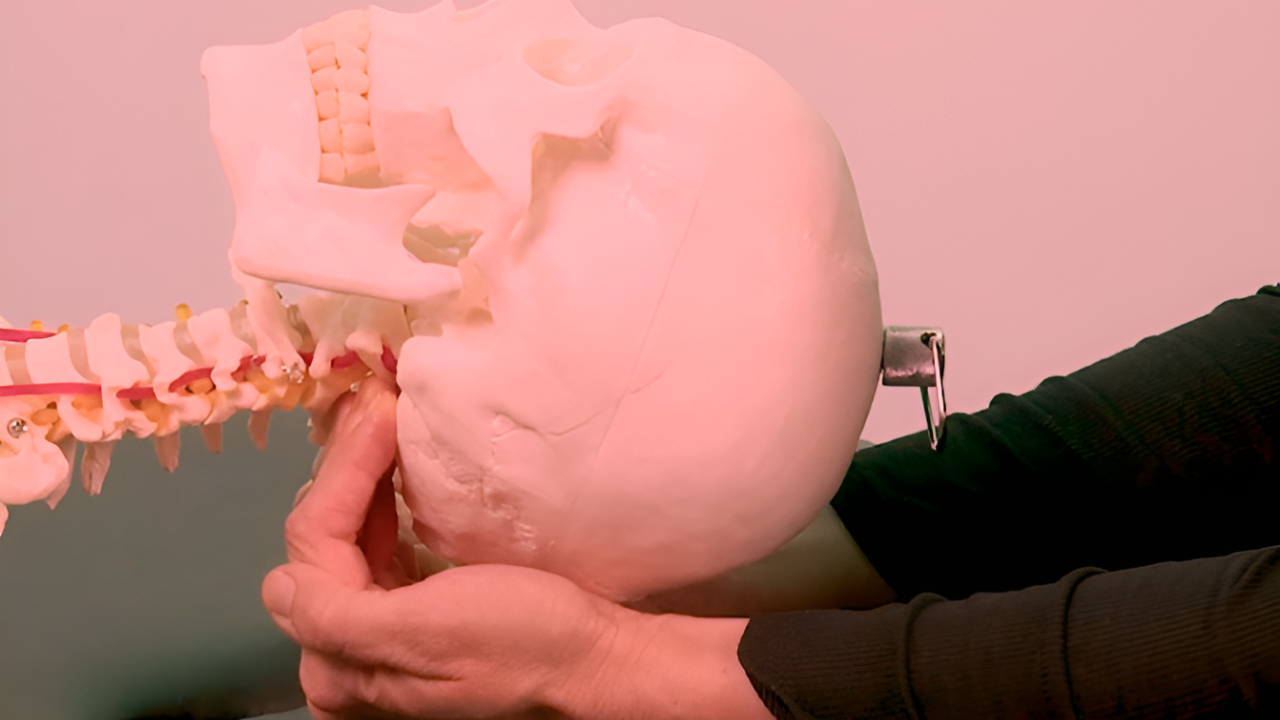Trigger Points - An Overview of the Evidence Base
Dr. Jonathan Kuttner Presents an Overview of the Evidence Behind Trigger Point Therapy
Drs. Janet Travell and David Simons (1992) described a trigger point as, “A highly irritable localised spot of exquisite tenderness in a nodule in a palpable taut band of (skeletal) muscle”
These hyperirritable localized spots can vary in size, and have been described as “tiny lumps,” “little peas,” and “large lumps”; they can be felt beneath the surface, embedded within the muscle fibers.
If these spots are tender to pressure they may well be “trigger points.”
The size of a trigger point nodule varies according to the size, shape, and type of muscle in which it is generated.
What is consistent is that they are tender to pressure. So tender in fact (hyperalgesia) that when they are pressed, the patient often winces from the pain. This is often referred to as the “jump sign.”
Myofascial trigger points may well be implicated in all types of musculoskeletal and mechanical muscular pain. Their presence has even been demonstrated in children and babies.
Pain or symptoms may be directly due to active trigger points, or pain may “build up” over time from latent or inactive trigger points.
Studies and investigations in selected patient populations have been carried out on various regions of the body.
There is a growing amount of research evidence directly linking musculoskeletal pain to trigger points.
A high prevalence of trigger points has been confirmed to be associated with myofascial pain, somatic dysfunction, psychological disturbance, and associated restricted daily functioning.
EmbryogenesisThere is some evidence that myofascial trigger points may be present in babies and children (Davies 2004); they have also been demonstrated in muscle tissue after death.
Trigger points develop in the myofascia (hence the descriptor myofascial trigger points or MTPs), mainly in the center of the muscle belly where the motor endplate enters (primary or central).
However, secondary or satellite trigger points often develop in a response to the primary trigger point.
These satellite points often develop along fascial lines of stress, which may well be “built- in” at the time of embryogenesis. External factors—such as ageing, body morphology, posture, weight gain, or congenital malformation—also play a crucial role in trigger point manifestation and genesis.
Evidence
In 1957, Dr. Janet Travell discovered that trigger points "generate and receive” minute electrical currents.
She determined experimentally that trigger point activity could be accurately quantified by measuring these signals with an electromyogram (EMG).

Local twitch response (LTR) in a rabbit tender spot. LTRs are elicited only when the needle is placed accurately within the trigger spot.
This is because electrical activity in a muscle in its resting state is “silent.” When a small part of the muscle goes into contracture, as with a trigger point, a small, localised spike in electrical activity occurs.
When needled with a monopolar teflon-coated EMG needle, trigger points have been demonstrated to elicit a local twitch response (LTR).
LTRs appear as high-amplitude polyphasic EMG discharges (Hong 1994, Wang & Audette 2000).
Trigger points have been reliably demonstrated by MRI's and there is an abundance of studies showing their efficacy.
Some key questions do remain unanswered however: What is the action of a needle that causes a muscle to contract?
Why is the twitch painful?
Why does the pain go away quickly?
Further Evidence
Shah et al. (2003) performed a micro-dialysis experiment, in which two tiny microtubules were inserted (within a hollowed-out acupuncture needle) into the trigger point of the upper trapezius muscle.
Saline solution was pumped through one tubule, while the other aspirated the local tissue fluid exudate.

Micro-dialysis findings
Nine subjects were selected for the study; of these, three were said to manifest active trigger points, three latent trigger points, and three no trigger points (control group).
To locate the trigger points, the subjects were first manually palpated, and then an algometer (pressure meter) was used to measure the amount of pressure required to elicit symptoms.
In each of the nine subjects the same zone of the upper trapezius was aspirated.
The results have thrown some more light on the internal pathophysiology within trigger points, suggesting localised tissue hypoxia, increased acute inflammatory cascade, and lowered pH (acidosis) (see Table above).
Notes to the Video
The video above is presented by Dr Jonathan Kuttner (MBBCH, Dip Sports Med, Dip MSM, FRNZCGP, FAFMM) who is a musculo-skeletal pain specialist and has spent the last 35 years working as a doctor and teaching in New Zealand.
He is the recipient of the NAMTPT Lifetime Award for Contribution to Myofascial Trigger Point Therapy and is regularly featured on national TV and radio.
Useful Links
Trigger Point Therapy - Where to Start?
Find a Trigger Point Professional in your area
Dry Needling for Trigger Points
Certify as a Trigger Point Therapist
About NAT Courses
As a manual therapist or exercise professional, there is only one way to expand your business - education!
Learning more skills increases the services that you offer and provides more opportunity for specialisation.
Every NAT course is designed to build on what you already know, to empower you to treat more clients and grow your practice, with a minimal investment in time and money.
Help Desk
About Niel Asher Education
Niel Asher Education is a leading provider of distance learning and continued education courses.
Established in the United Kingdom in 1999, we provide course and distance learning material for therapists and other healthcare professionals in over 40 countries.
Our courses are accredited by over 90 professional associations and national accreditation institutions including the National Academy of Sports Medicine (NASM) and National Certification Board for Therapeutic Massage and Bodywork (NCBTMB). Full details of all international course accreditations can be found on our website.
Printed course materials and other products offered on our websites are despatched worldwide from our 3 locations in the UK (London), USA (Pennsylvania) and Australia (Melbourne).
More About Us
NAMTPT AWARD
We are honored to have received the 2017 "Excellence in Education" Award from the National Association of Myofascial Trigger Point Therapists.
Since 1999 Niel Asher Education has won numerous awards for education and in particular for education and services provided in the field of trigger point therapy.
Read Full Article
Award Winning Instructors
Niel Asher Healthcare course instructors have won a host of prestigious awards including 2 lifetime achievement honorees - Stuart Hinds, Lifetime Achievement Honoree, AAMT, 2015, and Dr. Jonathan Kuttner, MD, Lifetime Achievement Honoree, NAMTPT 2014.
Meet the Instructors
NAT Certification
If you are a qualified/licensed manual therapist or exercise/fitness professional you can expand your credentials with NAT certification.
In addition to national accreditation for continued education, each course that we offer includes "NAT Learning Credits". By taking and completing courses you can accumulate NAT credits to qualify for NAT certification.
There are currently 3 levels of NAT certification. Certifying NAT is a valuable way to show your clients that you take continued education seriously, and to promote your skills and qualifications.
About NAT Certification
Niel Asher Technique
Since 1999 the Niel Asher Technique for treating trigger points has been adopted by over 100,000 therapists worldwide, and has been applied to the treatment of a number of common musculoskeletal injuries.
The Niel Asher Technique for treating frozen shoulder was first introduced and published in 1997 and has been widely adopted by therapists and exercise professionals working within elite sports and athletics.
Read More
Worldwide Free Shipping
Most of our courses are available as either "Printed" or 'Download" editions. When you purchase a download edition, you receive immediate lifetime access to all course material. Course texts can be downloaded and printed if required.
When you purchase a "Printed" edition, you will also receive free access to the download edition.
We ship Worldwide from locations in the USA, UK, and Australia. Most items are despatched within 24 hours and shipping is FREE for all orders over US$50.
Shipping
This trigger point therapy blog is intended to be used for information purposes only and is not intended to be used for medical diagnosis or treatment or to substitute for a medical diagnosis and/or treatment rendered or prescribed by a physician or competent healthcare professional. This information is designed as educational material, but should not be taken as a recommendation for treatment of any particular person or patient. Always consult your physician if you think you need treatment or if you feel unwell.

Learn More for Less

Unlimited access to all courses for just $19.95/mo











